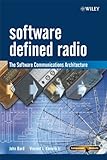Software defined radio : the software communications architecture / John Bard, Vincent J. Kovarik, Jr.
By: Bard, John [author.] .
.
Contributor(s): Kovarik, Vincent J | IEEE Xplore (Online Service) [distributor.]
| IEEE Xplore (Online Service) [distributor.] | Wiley [publisher.]
| Wiley [publisher.] .
.
Material type:  BookSeries: Wiley series in software radio: Publisher: Chichester, England ; John Wiley, c2007Distributor: [Piscataqay, New Jersey] : IEEE Xplore, [2007]Description: 1 PDF (xxi, 439 pages) : illustrations.Content type: text Media type: electronic Carrier type: online resourceISBN: 9780470865200.Subject(s): Software radio
BookSeries: Wiley series in software radio: Publisher: Chichester, England ; John Wiley, c2007Distributor: [Piscataqay, New Jersey] : IEEE Xplore, [2007]Description: 1 PDF (xxi, 439 pages) : illustrations.Content type: text Media type: electronic Carrier type: online resourceISBN: 9780470865200.Subject(s): Software radioIncludes bibliographical references (p. [429]-430) and index.
Acknowledgments -- Foreword -- Preface -- Audience -- Scope -- Conventions Used in this Book -- Organization -- Additional Material and Author Contact -- PART I The Operating Environment (OE) -- 1 Introduction -- 1.1 Software Radios -- 1.2 The Software Communications Architecture -- 1.3 The Operating Environment -- 1.4 The SCA Specification Structure -- 1.5 Summary -- 2 Operational Scenarios -- 2.1 Startup -- 2.2 Shutdown -- 2.3 Application (Un)Installation -- 2.4 Instantiate Application -- 2.5 Control Application -- 2.6 System Configuration -- 3 General Requirements and Services -- 3.1 Non-Functional Requirements -- 3.2 Name Service -- 3.3 Event Service -- 3.4 Log Service -- 3.5 FileSystem -- 3.6 File -- 4 Foundation Interfaces and Data Types -- 4.1 TestableObject -- 4.2 PortSupplier -- 4.3 LifeCycle -- 4.4 PropertySet -- .5 Resource -- 4.6 ResourceFactory -- 4.7 Port -- 5 Devices and the Device Manager -- 5.1 Introduction -- 5.2 Device -- 5.3 LoadableDevice -- 5.4 ExecutableDevice -- 5.5 AggregateDevice -- 5.6 DeviceManager. / -- 6 Domain Management -- 6.1 DomainManager -- 6.2 FileManager -- 6.3 The ApplicationFactory -- 6.4 Application -- 7 Operating Environment Security -- 7.1 Core Framework Security Requirements -- 8 Certification -- 8.1 Certification Process -- 8.2 Operating Environment Certification -- 8.3 Waveform Assessment and Certification -- PART II The Domain Profile -- 9 The Domain Profile -- 9.1 Overview -- 9.2 SCA Domain Profile XML -- 9.3 Domain Profile Data Types -- 10 Base Descriptor Files -- 10.1 Properties Descriptor -- 10.2 softpkg -- 10.3 Software Component Descriptor -- 10.4 Device Package Descriptor -- 11 Device Configuration Descriptor -- 11.1 Overview -- 11.2 deviceconfiguration -- 12 The Domain Manager Descriptor -- 12.1 Overview -- 13 The Software Assembly Descriptor -- 13.1 Overview -- PART III Building an SCA-Compliant System -- 14 The POSIX Operating System -- 14.1 An Operating Environment -- 14.2 Linux 2.6 Kernel -- 15 POSIX Threads.
15.1 The Thread Object -- 15.2 Un-named Semaphores -- 15.3 Mutex Variables -- 15.4 Thread Attributes -- 15.5 Conditional Variables -- 15.6 Less Interesting Thread Calls -- 16 All ORBS are not Created Equal -- 16.1 CORBA Basics -- 16.2 The Object Management Group. / -- 16.3 'C' ORB versus C++ ORBs -- 16.4 Initial Services -- 16.5 The Interface Repository -- 16.6 Minimum CORBA -- 16.7 The Portable Object Adapter (POA) -- 16.8 Real-time CORBA -- 16.9 Overview of Available ORBs -- 17 The Services -- 17.1 Interoperable Naming Service -- 17.2 Event Service -- 17.3 Log Service -- 18 Exploring the Domain -- 18.1 Application Factory Attributes -- 18.2 Application Attributes -- 18.3 DeviceManager Attributes -- 18.4 Device Attributes -- 18.5 AggregateDevice Attributes -- 18.6 DomainManager Attributes -- 18.7 Properties -- 18.8 Manipulating Ports -- 18.9 Summary -- 19 An SCA-compliant Application -- 19.1 Hello World Legacy Application -- 19.2 Legacy Hello World SPD -- 19.3 HMI Applications -- 19.4 Shutting Down -- 19.5 An SCA-compliant Hello World Application -- Appendix A Mandatory POSIX Calls -- Appendix B References to Part III -- Index.
Restricted to subscribers or individual electronic text purchasers.
The Software Communications Architecture (SCA) establishes an implementation-independent framework for the development of Joint Tactical Radio System software configurable radios. It specifies the Operating Environment, services and interfaces that applications use. Software Defined Radio: The Software Communications Architecture focuses on the issues and benefits associated with developing a radio system in compliance with the SCA specification. This book provides a comprehensive, practical introduction to building a SCA-compliant system taking the reader through the historical and conceptual background to help filling in the gaps between the intent of the SCA specification and the practice. Key features: . Presents a practical approach to the Software Communications Architecture. Provides an example-oriented understanding of the usage of the SCA and thus allows the reader to extend the concepts and practice to more complicated multi-processor distributed environments.. Covers the Operating Environment: a Core framework, CORBA middleware, POSIX operating systems and Domain profiles.. Features an accompanying website with appendices, and links to further information on the SCA. This invaluable reference will provide applications programmers, designers, professional researchers, wireless manufacturers and operators with an indispensable guide to the Software Communications Architecture. Advanced undergraduate and postgraduate students on mobile and wireless communications courses will also find this to be an excellent guide to the topic.
Also available in print.
Mode of access: World Wide Web
Description based on PDF viewed 10/24/2017.


There are no comments for this item.